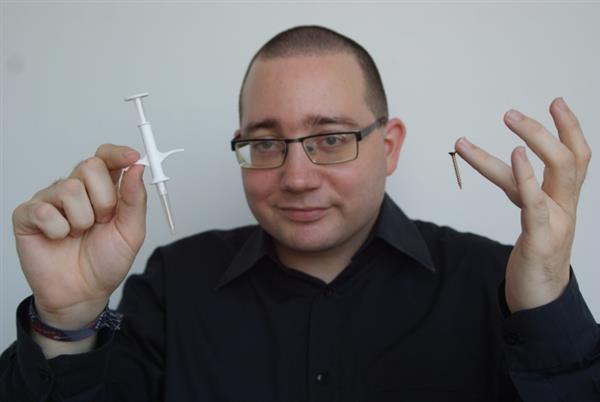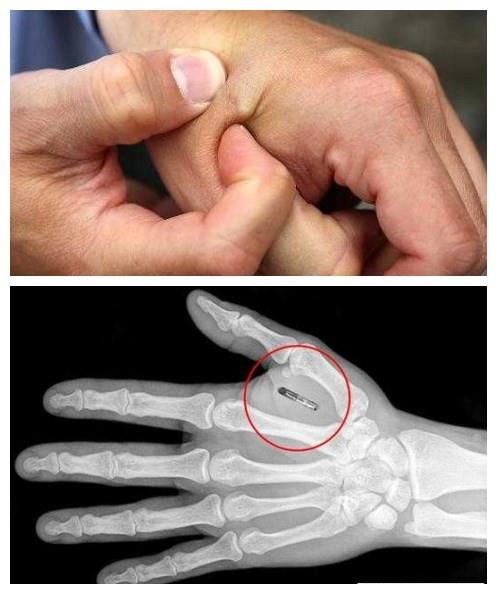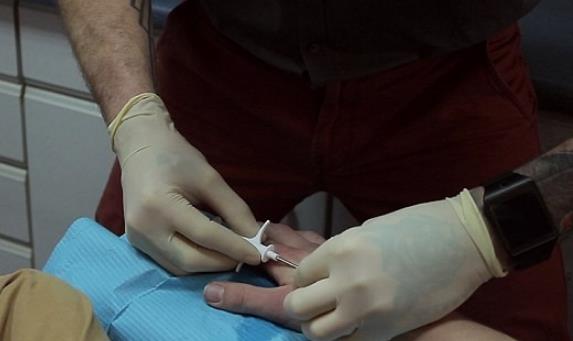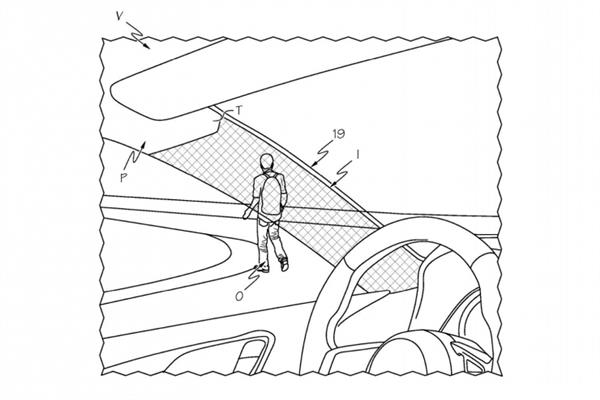Have you ever thought about a scenario where your home keys, access cards, car keys, subway cards, bank cards and other things that are closely related to personal safety and property safety can be replaced by a small chip implanted in your body in the future? ? This sounds like a sci-fi scene. It is actually being implemented by Patrick Paumen, a bio-hacker from the Netherlands. Lei Feng recently conducted an exclusive interview with the world's top bio-hackers.
Unlock access cards, car locks, computer passwords... this is a wave of things
At present, there are 9 RFID (radio frequency identification) implantable tags in my body. Their frequencies, protocols, and functions vary. Some allow me to gain access to buildings, and some allow me to share contact information or other information. The data, also with a temperature sensor, will be displayed on the reader screen when the reader scans the RFID implantable tag.
Patrick Paumen is a staunch supporter of bioimplantation chips. In his world, there is no such thing as losing all kinds of keys and forgetting the power-on password, as long as he does not lose himself!

But you can't expect to have all locks on just one chip. For now, different door locks or RFID access control system manufacturers use different frequencies and different protocols. He must implant multiple RFID tags to be compatible with different types of RFID technology.
Therefore, before deciding to use an RFID implanted chip to replace a key, access card, or keychain, it is necessary to clarify the frequency of use and the protocol to determine which items need to be implanted.
In addition to implanted chips that can replace these common cards, he will even include chips in his arm that can run Java applets. Patrick Paumen said that the implant, called the VivoKey, and the contactless smart card are Similarly, it is an implantable NFC platform for identity, security, encryption, and payment applications.
Is this safer? Patrick Paumen gave a positive answer.
One of my RFID-embedded tags is used in combination with an external NFC reader to replace my computer password. The external NFC reader acts as a USB HID (human interface device such as a keyboard or mouse) when the NFC reader scans When I implant, the microcontroller checks whether the UID number is valid and sends a string (my password) to the computer. The advantage of this is that it prevents “shoulder peeping” and that others cannot peep behind the shoulders to peep at the password being entered.
Another method is to use the VivoKey implant to generate the OTP authentication code to unlock the computer. Use the keypad to enter the OTP authentication code and send the password to the computer. This is more secure because the OTP code is only valid for 30 seconds.
Where is the chip implanted in the body? How often do you maintain it? Put into the palm of your hand and stay with you!
Usually, people who try to implant chips into their own bodies will have a variety of questions. After all, these frequently appearing sci-fi movies seem to be far away from ordinary life.

The chip is usually implanted between the thumb and forefinger because it can avoid bones and complicated nerve areas. It is usually implanted with a syringe and feels like an injection.
To avoid infection, these chips will have a layer of bio-coating added at the time of implantation. As we all know, metals are poisonous!

Because the RFID-implanted tag is a passive device, it means that it does not require a battery. It only supplies power through induction when it is close to the reader, and the life of the chip can be accompanied by a person's lifetime.
When the data needs to be changed, the only maintenance required for the VivoKey implant is to change the data on the NFC platform on the smartphone without taking the implant out of the body.
Does it sound like it is burning? After filling a subway card, you no longer need to line up. You just need to use your right hand to hold the phone and you can charge the left hand chip with money!
Waved hands can buy and buy when the scene can be achieved? This is a bit difficult.
"Using implants instead of payment cards is difficult to achieve!" Patrick Paumen bluntly stated that implants cannot be used for financial transactions at present and they do not support the purchase of products at all payment terminals.
However, some people with RFID-implanted tags can pay for food and drinks at gyms, schools, or offices because these companies have their own payment systems. They can use RFID implanted tags instead of gym-issued bracelet keys or office access cards/key fobs. In addition, some other people with implants are currently experimenting with the Bitcoin cryptocurrency system.
In theory, we can ask the bank to send another payment card, then remove the chip from the card, design and add the antenna coil, and then add the coating to ensure that it is safely implanted in the body. But there are some challenges. First, the payment card is a bank's asset and must be returned on demand. If it is damaged by the implant, it cannot be returned. Even if it is not damaged, the payment card has a valid date and needs to be replaced every few years. once,
But this is not a big problem for me. In our country, contactless payments have a certain limit. If you make multiple micropayments and eventually reach the limit of 50 euros, then when you pay again, the payment terminal will You are required to insert the payment card into the card slot. If I insert the chip into the body, how can I insert it into the card slot?
Patrick Paumen hopes that he can find financial institutions such as credit card companies or banks willing to cooperate and change this situation.
My body is my master, in the future these implanted chips can do some tricks?
Before we predict the future, we must first review the history.
In the decades that RFID technology has existed, the following things have happened.
In 1998, Professor Kevin Warwick implanted an RFID tag in his arm to facilitate the opening of the door and control of lights and electronic devices.
In 2004, the Barcelona Beach Club in Barcelona, Spain and Rotterdam, the Netherlands, provided their VIP members with RFID-implanted tags that allowed them to use these tags to enter VIP rooms and pay for drinks.
In 2005, Amal Graafstra became the first person to implant two RFID implants globally.
Amal's hands were implanted with a small RFID transponder, and he still uses them to open doors, open doors, log on to computers, and operate smart guns activated by implants.
After implanting these transceivers, he wrote a book entitled "RFID Toys", became a TEDx guest speaker, appeared on many television programs, and also produced many documentaries. He also founded a bio-hacking company called Dangerous Things, which developed the world's first and only NFC-compliant implantable transceiver. He continues to explore biological hacking and transhumanism and is currently developing next-generation implantable technology at the Seattle headquarters.
In the past few years, the United States CityWatcher (2006), Sweden's Epicenter (2015), Belgium's New Fusion (2016) and the United States Three Square Market (August 2017) have provided their employees with alternative RFID implantable tags to replace Keys and access cards.
-------------- Imagine the beautiful future dividing line -------------
In Sweden, people riding the train have begun using implants instead of tickets. In the next two decades, the chip implant will become more popular and more companies will provide its employees with this option.
People will use passive implants to replace RFID tags in new ways, such as RFID cards on nails, key rings, necklaces, rings, stickers and wristbands, such as tickets, concert tickets, hotel membership cards, and public transportation. Cards, etc.
In the future, biological hackers will also allow their children to have a certain understanding of the implant from an early age.
I read in a news report that a couple has RFID/NFC implantable tags on their bodies. Their youngest son always imitates his parents and tries to open the door by waving his hand to the cylindrical electronic lock. If parents have implants or other physical modifications, their next generation will become accustomed to implants and body modifications.
Patrick Paumen predicts that in the future people will develop self-powered active implants and introduce a new series of implants.
For example, implants with microcontrollers, sensors, BLE, and LEDs. In the future, we will also develop medical implants with body medical sensors such as heart rate monitor, blood gluغير مجاز مي باشدe monitor, and BCI (Brain Machine Interface).
In the next month, Patrick Paumen will also come to China to participate in ISC 2017. He will demonstrate how to clone a RFID card using a cloning device and then pour it into his own implanted chip.
Solar Panels
Solar Panels,182Mm Solar Panel,166Mm 9Bb Solar Panel,Solar Panel Efficiency
Jiangxi Huayang New Energy Co.,Ltd , https://www.huayangenergy.com
برچسب:
،
ادامه مطلب
بازدید:
























